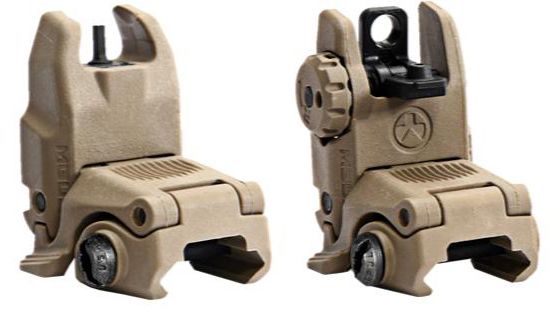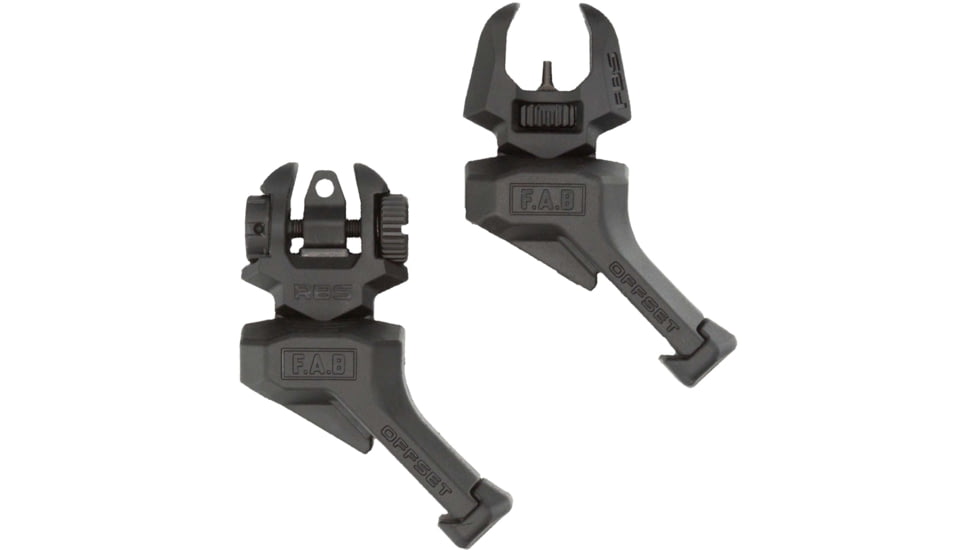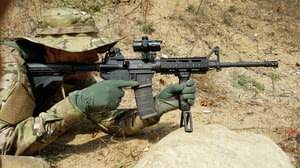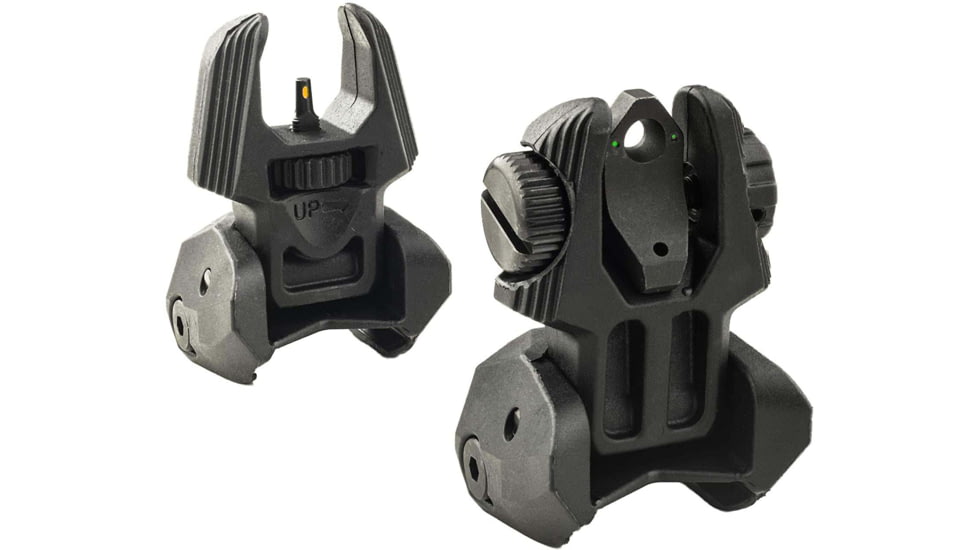A prominent part of any rifle or carbine, AR15 iron sights are a 2-piece mechanical sighting system that you can use as a primary or backup sighting option to aim a firearm accurately. They consist of a rear sight that uses a ghost ring or peep sight, which is located closer to the shooter’s eye and mounted on the upper receiver’s rail system. Iron sights also have a front sight that consists of a thin vertical post, which is located closer to the muzzle. Iron sights cost less than red dot sights and rifle scopes, since they are mostly used for close-range engagements. However, this makes them a great option for equipping a firearm on a budget. Backup iron sights (BUIS) are also an excellent low-profile choice to have on your AR 15 because they don’t use batteries, so if your primary optic fails, you can still get an accurate sight picture. There are many options including fixed sights, folding sights, and offset sights. This guide will cover most iron sight options available as well as their pros and cons, allowing you to make an educated decision on what to use.![]()
What Are the Types of AR15 Iron Sights?
Fixed Sights
Fixed sights are iron sights that are mounted in a single solid position, and do not offer the ability to fold out of the way. Since they are fixed in their upright position, they are usually more durable as there are no moving parts on the body. This style of iron sight is ideal for a new shooter who does not have a holographic or red dot sight, or does not intend to purchase one. They are also good for shooters who want to have their sights co-witness with their optics and don’t mind having the front and rear sight in their sight picture.
Folding Sights
 Folding sights, also known as flip up iron sights, offer the ability to fold flat to your receiver when not in use. This is a popular option for shooters looking for a backup option to their primary optic in the case it ceases to function. Having the ability to fold them flat gives the shooter a clear sight picture through their primary optic without having the iron sights obstruct their sight picture. In the case the optic goes down, simply flip the sights to their upright position. Many folding sights are also spring loaded, like the Magpul MBUS family of iron sights, allowing you to quickly deploy them at a moment's notice.
Folding sights, also known as flip up iron sights, offer the ability to fold flat to your receiver when not in use. This is a popular option for shooters looking for a backup option to their primary optic in the case it ceases to function. Having the ability to fold them flat gives the shooter a clear sight picture through their primary optic without having the iron sights obstruct their sight picture. In the case the optic goes down, simply flip the sights to their upright position. Many folding sights are also spring loaded, like the Magpul MBUS family of iron sights, allowing you to quickly deploy them at a moment's notice.
Offset Sights
 Offset sights mount to the flattop rail on your rifle and hang off to the side of your receiver at an angle. They are also known as canted sights, and they can be fixed or folding. The folding ability reduces the likelihood of them snagging on something when not in use. Offset sights are used as BUIS for shooters who may not have enough available rail space to mount standard fixed or flip up sights. They are most commonly mounted at a 45-degree offset, so you don’t have to move the weapon as much to aim. They are also useful for shooters who use a magnified optic for long-range shooting, as that optic is difficult to use on close-range targets. If you are using a low-power variable optic (LPVO) or similar style scope and need to quickly transition from a target at distance to a target up close, or vice versa, having offset iron sights gives you the ability to cant your rifle and utilize the sights for closer engagements without having to adjust the magnification on the optic.
Offset sights mount to the flattop rail on your rifle and hang off to the side of your receiver at an angle. They are also known as canted sights, and they can be fixed or folding. The folding ability reduces the likelihood of them snagging on something when not in use. Offset sights are used as BUIS for shooters who may not have enough available rail space to mount standard fixed or flip up sights. They are most commonly mounted at a 45-degree offset, so you don’t have to move the weapon as much to aim. They are also useful for shooters who use a magnified optic for long-range shooting, as that optic is difficult to use on close-range targets. If you are using a low-power variable optic (LPVO) or similar style scope and need to quickly transition from a target at distance to a target up close, or vice versa, having offset iron sights gives you the ability to cant your rifle and utilize the sights for closer engagements without having to adjust the magnification on the optic.
What Does Co Witness Mean?
 A co-witness is when your iron sights are visible in the window of your optic. There are 2 main options available for co-witnessing iron sights. These are known as an absolute and lower 1/3 co-witness. Absolute co-witness means that when your iron sights are fully visible in your optic window the red dot or reticle aligns with the post on your front sight. This eliminates the need to realign your weapon because both your iron sights and dot are on the same viewing plane. The downside to having an absolute co-witness is that it may seem more cluttered in the optics window, reducing your overall awareness.
A co-witness is when your iron sights are visible in the window of your optic. There are 2 main options available for co-witnessing iron sights. These are known as an absolute and lower 1/3 co-witness. Absolute co-witness means that when your iron sights are fully visible in your optic window the red dot or reticle aligns with the post on your front sight. This eliminates the need to realign your weapon because both your iron sights and dot are on the same viewing plane. The downside to having an absolute co-witness is that it may seem more cluttered in the optics window, reducing your overall awareness.
A lower 1/3 co-witness implies that your iron sights are only visible in 30% of the optic window. Typically, you need a higher mount for the optic to achieve this co-witness. This results in a less cluttered optic window while still allowing you to use the iron sights as a backup option. However, because the front post on your iron sight is not aligned with your dot, you must adjust your angle slightly when transitioning between your dot and iron sights. For both options, the front sight can act as reference point when firing from unconventional positions. The ability to have a backup option in the case your optic fails is very beneficial as you still have the ability to engage targets.
How Are Ghost Rings & Peep Sights Different?
Peep sights, also known as aperture sights, offer precision at longer distances because the rear sight aperture has a small, circular opening. Ghost ring sights feature a larger circular opening which equates to less precision and accuracy, but increased target acquisition speed at closer ranges. Many modern iron sights offer both a ghost ring and peep sight in the rear sight allowing the shooter to flip between the larger ghost ring for closer engagements and the smaller peep sight for precision shooting. This set of iron sights is a good combo because it gives you a lot of versatility as long as you practice the fundamentals of using both ghost rings and peep sights.
What Are Tritium & Fiber Optic Iron Sights?
 Most AR15 iron sights use a standard blacked out front & rear sight. This is fine for most shooters as they do not use iron sights as their primary sighting system. However, some shooters use iron rifle sights as their primary sight system and would like to utilize their rifle in low light situations. Having a tritium or fiber optic front or front and rear sight allows the shooter to see and use their iron sights in low-light conditions that can prevent a proper sight picture with blacked out sights. Tritium and fiber optic sights are particularly useful for home defense, as you don’t have to turn the lights on to see the sight picture or get a safe point of impact. Several companies offer different front sight posts to replace your standard front sight, with Trijicon being one of the most popular. You can choose between different colors of tritium as well as different shaped posts like chevrons, spikes, circle dots and more. Some rifles will come from the manufacturer with tritium or fiber optics already installed, while others will require you to purchase and swap your original front post or rear aperture with a tritium version.
Most AR15 iron sights use a standard blacked out front & rear sight. This is fine for most shooters as they do not use iron sights as their primary sighting system. However, some shooters use iron rifle sights as their primary sight system and would like to utilize their rifle in low light situations. Having a tritium or fiber optic front or front and rear sight allows the shooter to see and use their iron sights in low-light conditions that can prevent a proper sight picture with blacked out sights. Tritium and fiber optic sights are particularly useful for home defense, as you don’t have to turn the lights on to see the sight picture or get a safe point of impact. Several companies offer different front sight posts to replace your standard front sight, with Trijicon being one of the most popular. You can choose between different colors of tritium as well as different shaped posts like chevrons, spikes, circle dots and more. Some rifles will come from the manufacturer with tritium or fiber optics already installed, while others will require you to purchase and swap your original front post or rear aperture with a tritium version.
Shop the Best AR15 Iron Sights & Parts Today!
Iron sights are a useful, cost effective tool that can be used as both a primary and a backup sighting system. Different styles and features allow you to choose the setup that works best for you. As your rifle configuration changes over time, you may need to change the kind of iron sights you use. But iron sights are a reliable investment and can be setup on almost any rifle configuration.
If you’re looking for help gearing up your AR 15 with high-quality equipment and attachments, our team at OpticsPlanet is here to help! With a wide selection of AR15 parts, including handguards, bolt carrier groups, and stocks, we have everything you need. And if you’re looking for ammo, we have a ton of .223 and 5.56 ammo in stock. If you’re looking for just AR 15 iron sights, check out some of our top brands, including Troy, Leapers UTG, and Midwest Industries.







